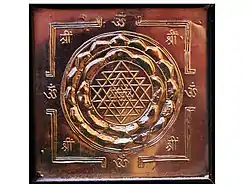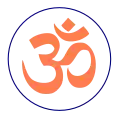| Bhavana Upanishad | |
|---|---|
 The text discusses the human body as Srichakra yantra.[1] | |
| Devanagari | भावन |
| IAST | Bhāvana |
| Title means | Feeling, internal visualization[2] |
| Date | ~15th-century CE[3] |
| Type | Shakta[4] |
| Linked Veda | Atharvaveda[5] |
| Chapters | 1[6] |
| Verses | 37[6] |
| Philosophy | Shaktism, Vedanta[7] |
The Bhavana Upanishad (Sanskrit: भावन उपनिषद्, IAST: Bhāvana Upaniṣad) is a medieval era minor Upanishad of Hinduism.[8] Composed in Sanskrit, the text is classified as one of the Shakta Upanishads and attached to the Atharvaveda.[5][6] The Upanishad identifies the human body as Srichakra yantra and elaborates on this theme,[1] and its worship.[9]
History
The author and the date when Bhavana Upanishad was composed are unknown. The text was likely composed, in the same period as other Shakta Upanishads, between the 12th- and 15th-century CE.[3] While this text is a relatively late composition in the Upanishadic collection, literary evidence confirms that Shakta Tantrism has roots in ancient times and the interaction between Vedic and Tantric traditions trace back to at least the sixth century,[10] and the surge in Tantra tradition developments during the late medieval period, states Geoffrey Samuel, were a means to confront and cope with Islamic invasions and political instability in and after 14th-century CE in parts of India and Tibet.[11]
The Bhavana Upanishad is a sister text to Tripura Upanishad.[12] Both of these texts were commented on the 18th-century Tantra and Mother goddess scholar Bhaskararaya.[13] The text has been popular in Srividya tradition of South India.[14][15]
The text was translated by AG Krishna Warrier in 1967. However, scholarly reviews such as those by Brooks have questioned the translation and its conservative modern interpretation that is inconsistent with how the text was interpreted by 15th- to 18th-century Indian scholars such as Bhaskararaya in their bhasya (review and commentary).[16]
Manuscripts of this text are also found titled as Bhavanopanisad.[1] In the Telugu language anthology of 108 Upanishads of the Muktika canon, narrated by Rama to Hanuman, it is listed at number 84.[17]
Contents
The Upanishad describes the human body to be Sri Yantra (Sri chakra), by mapping each part of the body to the chakra.[1] It asserts that the Shakti is the Atman (soul) within. The text is notable for its emphasis on Antaryaga (internal worship) in contrast to external rituals and offerings.[18] The 18th-century scholar Bhaskararaya, in his commentary, explains verse 29 of the Bhavana Upanishad to be based on the premise "all love their own self".[19]
The text presents nondualistic ideas, presenting Goddess as the supreme reality of the universe.[14][20] The philosophical premises in this text as in many Shakta Upanishads, states June McDaniel, is syncretism of Samkhya and Advaita Vedanta schools of Hindu philosophy, called Shaktadavaitavada (literally, the path of nondualistic Shakti).[21]
See also
References
- 1 2 3 4 Vedic Literature, Volume 1, A Descriptive Catalogue of the Sanskrit Manuscripts, Vol 1, Part 3, p. PA488, at Google Books, Government of Tamil Nadu, Madras, India, pages 488-491
- ↑ Teun Goudriaan (1992). Ritual and Speculation in Early Tantrism: Studies in Honor of Andre Padoux. State University of New York Press. p. 112. ISBN 978-0-7914-0898-8.
- 1 2 Cush 2007, p. 740.
- ↑ Warrier 1967, pp. 67–73.
- 1 2 Tinoco 1996, p. 88.
- 1 2 3 Narayanaswami 1999.
- ↑ Mahadevan 1975, pp. 238–239.
- ↑ Mahadevan 1975, pp. 234–239.
- ↑ Mahadevan 2006, p. 204.
- ↑ Brooks 1990, p. xii.
- ↑ Geoffrey Samuel (2010), Tantric Revisionings, Motilal Banarsidass, ISBN 978-8120827523, pages 60-61, 87-88, 351-356
- ↑ Brooks 1990, pp. 35, 77.
- ↑ Brooks 1992, pp. 54–57, also 42-43.
- 1 2 Brooks 1990, pp. 35–39.
- ↑ Brooks 1992, p. 41.
- ↑ Brooks 1990, pp. xvi–xvii, 213–214, 248.
- ↑ Deussen 1997, pp. 556–557.
- ↑ Brooks 1990, pp. 37–38, 77.
- ↑ Guru 1977, p. 114.
- ↑ Warrier 1967, pp. v–xiv, 67–73.
- ↑ McDaniel 2004, pp. 89–91.
Bibliography
- Brooks, Douglas Renfrew (1990). The Secret of the Three Cities. University of Chicago Press. ISBN 978-0226075693.
- Brooks, Douglas Renfrew (1992). Auspicious Wisdom. State University of New York Press. ISBN 978-0791411452.
- Colebrooke, Henry Thomas; Colebrooke, Sir Thomas Edward Colebrooke; Cowel, Edward Byles l (1873). Miscellaneous Essays: Miscellaneous essays, by H. T. Colebrooke. New ed., with notes, by E. B. Cowell. Trübner. p. 101.
- Cush, Denise; et al. (2007). Encyclopedia of Hinduism. Routledge. ISBN 978-0700712670.
- Deussen, Paul (1997). Sixty Upanishads of the Veda. Motilal Banarsidass. ISBN 978-81-208-1467-7.
- Narayanaswami, PP (1999). "भावोपनिषत् (Bhavana Upanishad)" (PDF) (in Sanskrit). Retrieved 26 February 2016.
- Guru, Narayana (1977). Life divine and spiritual values. Swami Sivananda Spiritual Centre : copies can be had from Satsangha Seva Samithi.
- Mahadevan, T. M. P. (2006). Los Upanishad Esenciales. LD Books. ISBN 970-732-184-9.
- Mahadevan, T. M. P. (1975). Upaniṣads: Selections from 108 Upaniṣads. Motilal Banarsidass. ISBN 978-81-208-1611-4.
- McDaniel, June (2004). Offering Flowers, Feeding Skulls. Oxford University Press. ISBN 978-0-19-534713-5.
- Tinoco, Carlos Alberto (1996). Upanishads. IBRASA. ISBN 978-85-348-0040-2.
- Warrier, AG Krishna (1967). Śākta Upaniṣads. Adyar Library and Research Center. ISBN 978-0835673181. OCLC 2606086.
